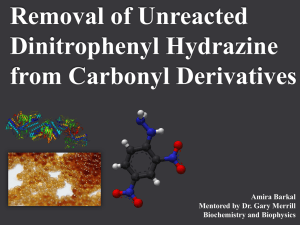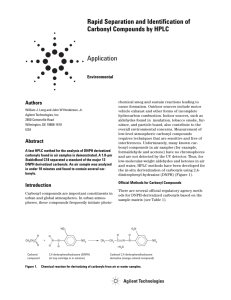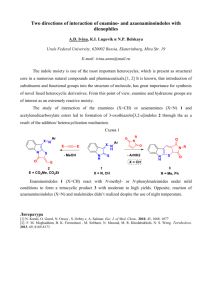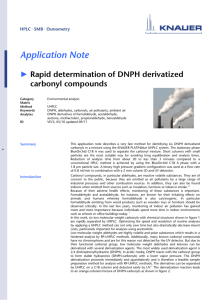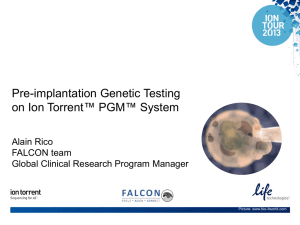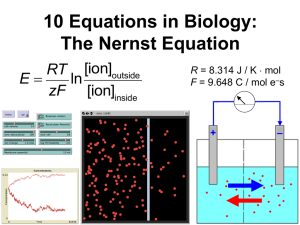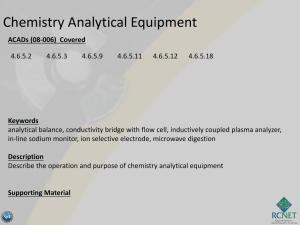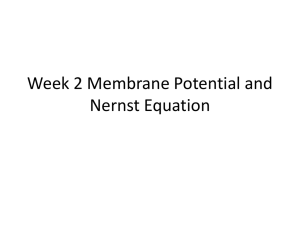Analysis of carbonyl-containing compounds derivatized
advertisement
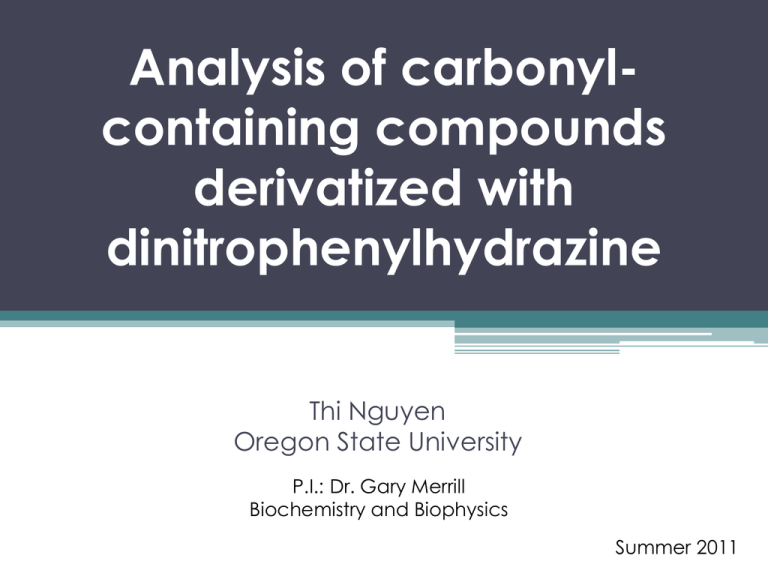
Analysis of carbonylcontaining compounds derivatized with dinitrophenylhydrazine Thi Nguyen Oregon State University P.I.: Dr. Gary Merrill Biochemistry and Biophysics Summer 2011 Carbonyl compounds Menadione Carbonyl compounds are compounds with aldehyde or ketone groups Carbonyls are a highly reactive species Build up of carbonyls cause carbonyl stress Pyruvate Carbonyl stress linked to diseases Linked to modification of proteins in diseases such as atherosclerosis and Alzheimer’s disease Atherosclerosis is slow and progressive; often leads to coronary heart disease (CHD) – the leading cause of death in America Alzheimer’s disease is the only cause of death among the top 10 in the US that cannot be prevented, slowed or cured http://www.pcna.net/national/documents/Atherosclerosis_Fact_Sheet.4.09.pdf http://www.alz.org/alzheimers_disease_facts_and_figures.asp Dinitrophenylhydrazine (DNPH) menadione-hydrazone menadione DNPH DNPH is a good derivatizing agent for stabilizing carbonyls Primary amine attaches to the carbonyl and forms a hydrazone Hydrazones Some hydrazones form precipitates Precipitates dissolve in different solvents depending on the hydrazone Hydrazone Formed in Precipitates Menadione 1 M HCl, Yes 23.8% EtOH Chloroform Blue Pyruvate 0.5 M HCl Yes 95% EtOH Brown α-Ketoglutarate 0.5 M HCl, Yes 47.5% EtOH 95% EtOH Brown n/a Brown 4-Hydroxynonenal 0.5 M HCl, No 47.5% EtOH Dissolves in Color under basic conditions Thin layer chromatography Fig. 2. TLC analysis of DNPH, menadione, and menadionehydrazone. Plate was immersed in NaOH, which stains the hydrazone blue. Glass silica plates Used to monitor formation of hydrazone by virtue of its blue color when exposed to base DNPH menadione menadionehydrazone TLC mass spectrometry (TLC-MS) samples are eluted from spot on TLC plate and directly analyzed in mass spec http://www.pharmaceutical-int.com/article/tlc-mass-spectrometry.html Menadione-Hydrazone Intensity, cps Expected mass: 352.0808 Observed mass: 351.075 m/z, Da Mass spectrometry: Collision-induced dissociation (CID) M2M1M3MParent ion Neutral Molecules Inert Gas Secondary ions CID: Menadione-Hydrazone Intensity, cps 109.0173 secondary ion 167.0107 secondary ion m/z, Da diminished 351.0745 parent ion 351.0745 Pyruvate-Hydrazone Intensity, cps 267.0376 Expected mass: 268.0444 Observed mass: 267.0376 m/z, Da CID: Pyruvate-Hydrazone Intensity, cps 182.0213 secondary ion secondary ion 122.0252 diminished parent ion m/z, Da Mass Spectrometry Summary The strongest candidates for a signature fragment from the DNPH-hydrazones are 182 and 122 m/z Hydrazone Parent ion (m/z) Secondary ions (m/z) menadione 351.0745 167.0107, 109.0173 pyruvate 267.0376 182.0213, 122.0252 α-ketoglutarate 325.0436 182.0211, 152.0227, 122.0247 4-hydroxynonenal 335.1372 182.0218, 167.0110, 122.0252 Proposed structures for secondary ions Generic DNPH-hydrazone Secondary Ion 182 m/z Secondary Ion 122 m/z Conclusion Promising signature fragments, 182 and 122 m/z, can be used in future assays to identify modeled carbonyl-compounds in cell extracts Further investigation is needed to confirm if these signature fragments apply to a wider range of DNPH-hydrazones Acknowledgements Dr. Gary Merrill Dr. Kevin Ahern Dr. Fred Stevens Dr. Jong-Tae Yang Jeff Morre Amira Barkal OSU Mass Spectrometry Laboratory Howard Hughes Medical Institute Cripps Undergraduate Research Oregon State University

